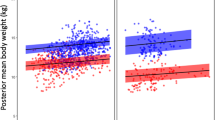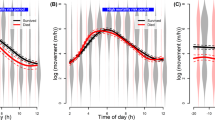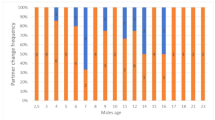Abstract
The authors provide an update to their 2006 report on the successful large-scale captive breeding of the 13-lined ground squirrel (TLGS; Ictidomys tridecemlineatus) in their colony, now a single-source supplier of purpose-bred TLGSs for several research institutions. With funding from the National Institutes of Health, the authors have expanded their capacity for breeding pairs and built a dedicated hibernaculum to house torpid animals in the facility. The authors report new information on housing, diet, environmental enrichment, breeding, behavior and health. They also report the findings of several in-house studies on the health, behavior and well-being of their TLGSs.
This is a preview of subscription content, access via your institution
Access options
Subscribe to this journal
We are sorry, but there is no personal subscription option available for your country.
Buy this article
- Purchase on Springer Link
- Instant access to full article PDF
Prices may be subject to local taxes which are calculated during checkout


Similar content being viewed by others
References
Helgen, K.M., Cole, F.R., Helgen, L.E. & Wilson, D.E. Generic revision in the holoarctic ground squirrel genus Spermophilus. J. Mammal. 90, 270–305 (2009).
Melvin, R.G. & Andrews, M.T. Torpor induction in mammals: recent discoveries fueling new ideas. Trends Endocrinol. Metab. 20, 490–498 (2009).
Heldmaier, G., Ortmann, S. & Elvert, R. Natural hypometabolism during hibernation and daily torpor in mammals. Respir. Physiol. Neurobiol. 141, 317–329 (2004).
Bouma, H.R. et al. Induction of torpor: Mimicking natural metabolic suppression for biomedical applications. J. Cell Physiol. 227, 1285–1290 (2012).
Linberg, K.A., Sakai, T., Lewis, G.P. & Fisher, S.K. Experimental retinal detachment in the cone-dominant ground squirrel retina: morphology and basic immunocytochemistry. Vis. Neurosci. 19, 603–619 (2002).
Van Hooser, S.D. & Nelson, S.B. The squirrel as a rodent model of the human visual system. Vis. Neurosci. 23, 765–778 (2006).
Organisciak, D.T. & Vaughan, D.K. Retinal light damage: mechanisms and protection. Prog. Retin. Eye Res. 29, 113–134 (2010).
Vaughan, D.K., Gruber, A.R., Michalski, M.L., Seidling, J. & Schlink, S. Capture, care, and captive breeding of 13-lined ground squirrels, Spermophilus tridecemlineatus. Lab Anim. (NY) 35, 33–40 (2006).
Institute for Laboratory Animal Research. Guide for the Care and Use of Laboratory Animals, 8th edn. (National Academies Press, Washington, DC, 2011).
Castelhano-Carlos, M.J. & Baumans, V. The impact of light, noise, cage cleaning and in-house transport on welfare and stress of laboratory rats. Lab. Anim. 43, 311–327 (2009).
Sakakibara, H. et al. Effects of animal care procedures on plasma corticosterone levels in group-housed mice during the nocturnal active phase. Exp. Anim. 59, 637–642 (2010).
Bardo, M.T. & Bevins, R.A. Conditioned place preference: what does it add to our preclinical understanding of drug reward? Psychopharmacology (Berl) 153, 31–43 (2000).
Panksepp, J.B. & Lahvis, G.P. Social reward among juvenile mice. Genes Brain Behav. 6, 661–671 (2007).
Glickman, S.E. & Schiff, B.B. A biological theory of reinforcement. Psychol. Rev. 74, 81–109 (1967).
Schneirla, T.C. in Nebraska Symposium on Motivation, 1959 (ed. Jones, M.R.) 1–42 (University of Nebraska Press, Lincoln, NE, 1959).
Young, P.T. The role of affective processes in learning and motivation. Psychol. Rev. 66, 104–125 (1959).
Panksepp, J., Herman, B.H., Vilberg, T., Bishop, P. & DeEskinazi, F.G. Endogenous opioids and social behavior. Neurosci. Biobehav. Rev. 4, 473–487 (1980).
Kelley, A.E. & Berridge, K.C. The neuroscience of natural rewards: relevance to addictive drugs. J. Neurosci. 22, 3306–3311 (2002).
Russell, R.L., O'Neill, P.H., Epperson, L.E. & Martin, S.L. Extensive use of torpor in 13-lined ground squirrels in the fall prior to cold exposure. J. Comp. Physiol. B 180, 1165–1172 (2010).
Whitaker, J. et al. Effects of cage size and enrichment on reproductive performance and behavior in C57BL/6Tac mice. Lab Anim. (NY) 38, 24–34 (2009).
Hurst, J.L. & West, R.S. Taming anxiety in laboratory mice. Nat. Methods 7, 825–826 (2010).
Brown, C. Novel food items as environmental enrichment for rodents and rabbits. Lab Anim. (NY) 38, 119–120 (2009).
Petri, I., Scherbarth, F. & Steinlechner, S. Voluntary exercise at the expense of reproductive success in Djungarian hamsters (Phodopus sungorus). Naturwissenschaften 97, 837–843 (2010).
Schwagmeyer, P.L. & Wootner, S.J. Scramble competition polygyny in thirteen-lined ground squirrels: the relative contributions of overt conflict and competitive mate searching. Behav. Ecol. Sociobiol. 19, 359–364 (1986).
French, S.S., Greives, T.J., Zysling, D.A., Chester, E.M. & Demas, G.E. Leptin increases maternal investment. Proc. Biol. Sci. 276, 4003–4011 (2009).
Mann, M.A., Kinsley, C., Broida, J. & Svare, B. Infanticide exhibited by female mice: genetic, developmental and hormonal influences. Physiol. Behav. 30, 697–702 (1983).
Carter, D.B., Kennett, M.J. & Franklin, C.L. Use of perphenazine to control cannibalism in DBA/1 mice. Comp. Med. 52, 452–455 (2002).
Blanchard, R.J., Flannelly, K.J. & Blanchard, D.C. Defensive behaviors of laboratory and wild Rattus norvegicus. J. Comp. Psychol. 100, 101–107 (1986).
Kruska, D.C. On the evolutionary significance of encephalization in some eutherian mammals: effects of adaptive radiation, domestication, and feralization. Brain Behav. Evol. 65, 73–108 (2005).
Kunzl, C. & Sacsher, N. The behavioral endocrinology of domestication: a comparison between the domestic guinea pig (Cavia aperea f. porcellus) and its wild ancestor, the cavy (Cavia aperea). Horm. Behav. 35, 28–37 (1999).
Stuermer, I.W. & Wetzel, W. Early experience and domestication affect auditory discrimination, learning, open field behavior and brain size in wild Mongolian gerbils and domesticated laboratory gerbils (Meriones unguiculatus forma domestica). Behav. Brain Res. 173, 11–21 (2006).
Yamamoto, M.E., Box, H.O., Albuquerque, F.S. & Arruda, M.D. Carrying behavior in captive and wild marmosets (Callithrix jacchus): a comparison between two colonies and a field site. Primates 37, 297–304 (1996).
National Research Council. Guidelines for the Humane Transportation of Laboratory Animals (National Academies Press, Washington, DC, 2007).
Acknowledgements
We thank the Wisconsin Alumni Research Foundation and the University of Wisconsin Oshkosh Office of Grants and Faculty Development for their support during the establishment of the squirrel colony. Major colony improvements were funded by NIH-NCRR Animal Facility Improvement Program. We also thank Matthew Rubin, Timothy Anderson and George Weir for their collective 5 years of diligent care and timely observations, many of which contributed to our current colony best practices.
Author information
Authors and Affiliations
Corresponding author
Ethics declarations
Competing interests
The authors declare no competing financial interests.
Rights and permissions
About this article
Cite this article
Merriman, D., Lahvis, G., Jooss, M. et al. Current practices in a captive breeding colony of 13-lined ground squirrels (Ictidomys tridecemlineatus). Lab Anim 41, 315–325 (2012). https://doi.org/10.1038/laban.150
Received:
Accepted:
Published:
Issue Date:
DOI: https://doi.org/10.1038/laban.150
This article is cited by
-
Changes in CO2 sensitivity during entrance into, and arousal from hibernation in Ictidomys tridecemlineatus
Journal of Comparative Physiology B (2022)
-
Establishing the ground squirrel as a superb model for retinal ganglion cell disorders and optic neuropathies
Laboratory Investigation (2021)
-
TRPs et al.: a molecular toolkit for thermosensory adaptations
Pflügers Archiv - European Journal of Physiology (2018)
-
Ethical considerations in hibernation research
Lab Animal (2013)



